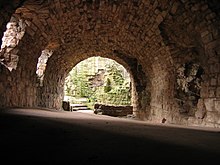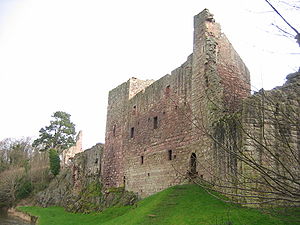Hailes Castle
| Hailes Castle | ||
|---|---|---|
|
North facade of Hailes Castle from the Tyne |
||
| Creation time : | 13-16 century | |
| Castle type : | Spurburg | |
| Conservation status: | ruin | |
| Standing position : | Scottish nobility | |
| Construction: | Quarry stone | |
| Place: | East Linton | |
| Geographical location | 55 ° 58 '20.6 " N , 2 ° 41' 2.8" W | |
| Height: | 36 m ASL | |
|
|
||
Hailes Castle is a ruined castle about 2.5 km southwest of East Linton in the East Lothian administrative division of Scotland . The riverside castle, mostly from the 14th century, belonged to the Hepburn family for much of the time . Since 1926 it has been under the administration of the Scottish State; today the competent authority is Historic Scotland . The ruin is open to the public and admission is free.
owner
The castle was built before 1300 as a fortified tower house for Hugo de Gourlay , making it one of the oldest examples of its kind in Scotland. Sovereignty over the lands was held by the Earls of Dunbar and March . The De Gourlays , a family from Northumbria , supported the English in the Scottish Wars of Independence , and so they had forfeited their lands to the Scottish Crown. Hailes Castle and the associated lands were given to another man from Northumbria, Sir Adam de Hepburn († before 1371), who in the reign of King David II a charter for the lands of Traprain , Southalls and Northalls (now united to Hailes ) in Haddingtonshire as well as for the lands of Mersingtoun , Cockburnspath and Rollanstoun in Berwickshire .
On December 20, 1451 Sir Patrick Hepburn, 1st Lord Hailes , received a charter from the Crown over the rule of Hailes and other dominions and lands which his predecessors once inherited as the Earls of March, who in turn held them for the crown; likewise the lands of Prendergast above Ayton and others in the sheriff's district of Berwick, with all rights to the lands previously held and forfeited by George Dunbar, Earl of March . All of this was summarized in the new Baronate Hailes . He was one of the keepers of the truce with the English in 1449, 1451-1457 and 1459. It is believed that Sir Patrick Hepburn had the castle greatly expanded. A massive tower with at least four stories was built to the west of the previous buildings, as well as a lower tower to the east, so that a long north wing emerged that loomed over the Tyne . The thick curtain wall of the castle may go back to the 13th century.
Sieges
In 1400 the castle withstood an attack by Harry 'Hotspur' Percy , who had allied himself with the Earl of March. The attackers were later defeated in a counterattack led by Archibald Douglas, Master of Douglas . A successful attack by Archibald Dunbar in 1443 was followed by a massacre of the castle's residents.
In July 1547, during Rough Wooing , John Lord Borthwick was made holder of "the place and fortress of Halis". He managed to keep them "safe against our old enemies of England and everyone else". He only agreed to leave the house to Regent Arran and not to Lord Bothwell or anyone else by the name of Hepburn. In case the English came, Regent Arran promised to send 24 horsemen to defend the castle. After the Battle of Pinkie Cleugh , Lord Gray of Wilton took it for the English.
In 1567 James Hepburn, 4th Earl of Bothwell , housed Mary Stuart at Hailes Castle. He later forfeited all of his lands, including Hailes Castle, to the Scottish Crown.
Oliver Cromwell had the building partially razed in 1650 after the Battle of Dunbar . The castle later passed into the hands of the Stewarts , the Setons and finally, in 1700, the Dalrymples of Hailes. The castle was used as a granary in the mid-19th century when Sir David Dalrymple , benefiting from the quieter times, moved with his family to Newhailes House .
description

The castle ruin stands on a rocky promontory above the Scottish Tyne and thus blocks this strategically important route and dominates the route to Edinburgh . Inside the curtain wall from the 13th century is the donjon from the 14th century, to which wings were added in the following two centuries. The largest surviving building is the west tower, a donjon with a square floor plan that makes the remains of the central tower that the Gourlays had built appear tiny, probably a replica from the 16th century. Work from the 15th century contains a chamber without a roof. In it, the remains of a tabernacle and piscina suggest that this was more of a chapel than a hall. A bakery and brewery from this period can also be found on the vaulted ground floor . The original tower served as a pigeon house after it was no longer inhabited. Only one finger of the masonry remains from the east tower.
Hailes Castle is a Scheduled Monument .
Individual evidence
- ↑ a b James Balfour Paul: The Scots Peerage. Volume 2: (Banff - Cranstoun). Douglas, Edinburgh 1905, under 'Bothwell': pp. 135–136 .
- ^ John Hill Burton (ed.): Register of the Privy Council of Scotland. (Series 1) Volume 1: AD 1545-1569. HM General Register House, Edinburgh 1877, p. 81.
- ↑ Scheduled Monument - Entry . In: Historic Scotland .
literature
- Martin Coventry: The Castles of Scotland. A comprehensive Reference and Gazetteer to more than 2700 Castles and Fortifies Sites. 3. Edition. Goblinshead, Musselburgh 2001, ISBN 1-89987-427-5 .
- Hugh Fenwick: Scotland's Castles. Robert Hale, London 1976, ISBN 0-7091-5731-2 .
Web links
- Hailes Castle . Historic Scotland. Retrieved August 23, 2017.


